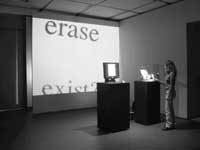|
before I was a frequent visitor to his lab and he to
my studio," Vesna says.
It was from these visits that she realized
the importance of making the work of the California NanoSystems Institute
(CNSI) (http://www.cnsi.ucla.edu) at UCLA accessible to the general
public.
Through their collaboration, Vesna and Gimzewski found
parallels between media arts and nanoscience. "We have very similar
concepts of breaking down traditional academic boxes," says Gimzewski. And
Vesna adds, "both are emerging disciplines, both promote unusual
connections and are outside the established systems of thought, and both
are experiencing growing pains and constant redefinition." Working closely
together to pose questions that neither would have considered alone while
conceptualizing and developing the CNSI website and "Zero@wavefunction,"
their project combines rigorous scientific thought with the critical
approach of visual culture to create a rich alternative narrative that
elucidates the complex behavior of molecules, while creating a completely
new interactive world.
Gimzewski and Vesna's encounter under the
auspices of SINAPSE is but one example of the synergy currently at play on
campus between the arts and science. SINAPSE, established last year with
the strong support of then dean, now executive vice chancellor Daniel
Neuman, is co-directed by media artist Vesna, scientist Gimzewski, and
humanist Katherine Hayles. Hayles, a professor in the departments of
English and Design | Media Arts, proposes a paradigm for the research and
educational environment of the |

An overview of the
installation entitled "database," an
electronic reading device
by Adriana de Souza e
Silva and Fabian Winkler |

A demonstration of
"Zero@wavefunction: nano dreams and nightmares," showing
how human shadows interact with virtual objects, photo
by Pete Connolly
'98 | |
future that reflects the fundamental
changes in society spurred by information technology.
Founded to foster an emerging culture that encourages
exploration and relationships beyond traditional disciplines,
SINAPSE's visionary mission emphasizes collaboration and
communication as a way to spark advances in yet unknown
directions.
"The new technology lends itself very well
to collaboration," says Hayles. "Since it is capable of
accepting input in many different forms—text, graphics, sound,
animation, etc.—it is ideal for collaboration between artists
and scholars coming from different traditions."
Fully
embracing digital media to bring the perspectives of disparate
disciplines together, SINAPSE proposes deeper and more radical
links than the "interdisciplinary" approach: "Exposure and
experimentation by faculty, staff, and students about living
in an information age," says the mandate, "encourage a culture
of digital adventure."
This new synergy builds an
infrastructure powered by advanced communications technologies
and institutes programs that include internal fellowships for
faculty and |
graduate students, along with coordinating grants. SINAPSE
also serves as a communications center for issues relating to
cross-discipline collaborations and research. The enterprise
addresses head-on the asymmetry on campus between the arts and
humanities on the one hand, and the sciences on the
other—striving to nurture the potential for growth and
opportunity in the collaborative process.
"Coming from
a textually-based discipline, the collaborative process is
extremely important in breaking new ground," says Hayles. "The
result is often surprising and more sophisticated because the
teamwork pushes each partner in new directions." When Hayles
and Bill Seaman, a former professor in D|MA, taught a graduate
seminar last winter that combined students from both the D|MA
and literary departments, they saw first-hand the synergy that
is possible among teams of students. One project from that
seminar—entitled "database"— was presented at
an international art conference in Brazil, and was awarded
first prize by the Association for Computer Aided Design in
Architecture (ACADIA) at their annual conference in
October. |
continued | |